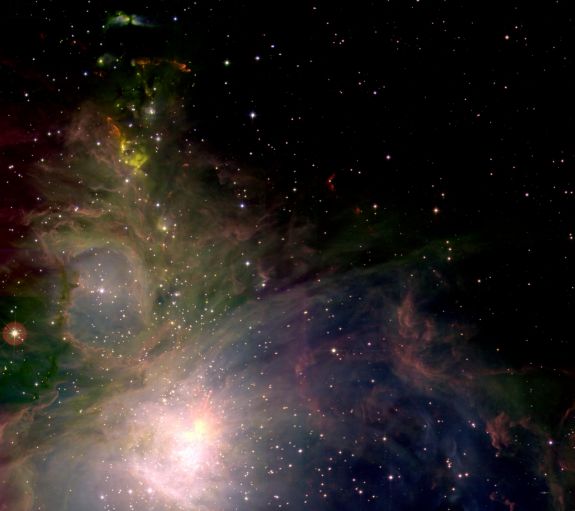Credit & Copyright: Joint Astronomy Centre;
image processing by C. Davis, W. Varricatt
Explanation:
At the edge of a dense
molecular
cloud, filaments of gas, cosmic dust, and
a multitude of young stars beckon in this penetrating image
of the Orion Nebula.
Alluring structures in the well-known star forming region
are
revealed here in infrared light as viewed
by a new Hawaiian eye - WFCAM - a powerful wide field camera
commissioned at the United Kingdom Infrared Telescope
(UKIRT)
on Mauna Kea.
Only a fraction
of WFCAM's full field, this
picture covers about 11 light-years at the 1,500 light-year
distance of the nebula.
In the image, otherwise invisible
infrared
light has been
mapped into visible colors.
Red represents narrow-band infrared emission from hydrogen
molecules at a wavelength of 2.12
microns,
green is emission at 2.2 microns, and
blue is emission at 1.25 microns.
Visible light has a wavelength of about 0.5 microns
(micrometers).
News: APOD editor to speak in January in New York
1999 2000 2001 2002 2003 2004 2005 2006 2007 2008 2009 2010 2011 2012 2013 2014 2015 2016 2017 2018 2019 2020 2021 2022 2023 2024 2025 |
Январь Февраль Март Апрель Май Июнь Июль Август Сентябрь Октябрь Ноябрь Декабрь |
NASA Web Site Statements, Warnings, and Disclaimers
NASA Official: Jay Norris. Specific rights apply.
A service of: LHEA at NASA / GSFC
& Michigan Tech. U.
|
Публикации с ключевыми словами:
Orion Nebula - infrared - star formation - molecular cloud - Туманность Ориона - инфракрасное излучение - звездообразование - Молекулярные облака
Публикации со словами: Orion Nebula - infrared - star formation - molecular cloud - Туманность Ориона - инфракрасное излучение - звездообразование - Молекулярные облака | |
См. также:
Все публикации на ту же тему >> | |
